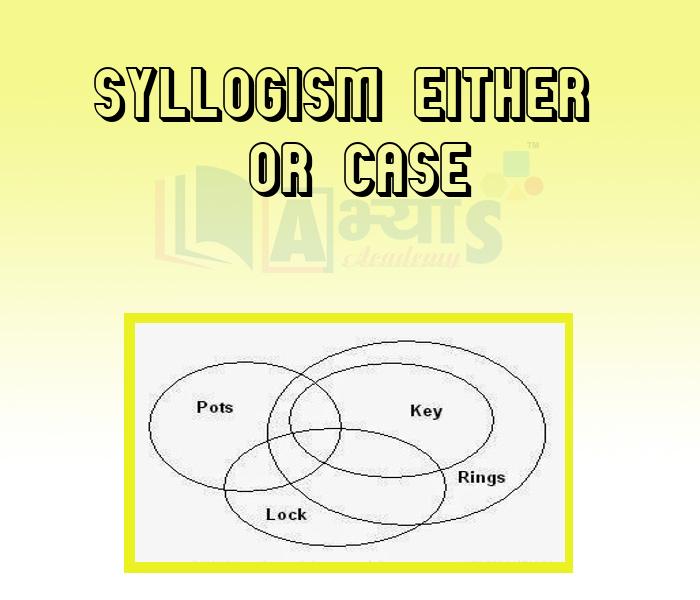Syllogism Either or Case






Syllogism Either or Case
Syllogism - Either or Case:
Illustration:: In the question below, two statements are given followed by Conclusions numbered I and II. The candidate has to assume all the statements to be true even if they seem to be at variance from the commonly known facts and then decide which of the given two Conclusions logically follows from the information given in the statements and mark the option best suited.
Statement :
In the question below, two statements are given followed by Conclusions numbered I and II. The candidate has to assume all the statements to be true even if they seem to be at variance from the commonly known facts and then decide which of the given two Conclusions logically follows from the information given in the statements and mark the option best suited.
Statements:
I. Some bed are table.
II. All chair are table.
. Conclusions:
I. At least some bed are chair.
II. Some bed are definitely not chair.
A. Only Conclusion I follows B. Only Conclusion II follows C. Either Conclusion I or II follows D. Neither Conclusion I nor II follows
Answer : C
In the question below, two statements are given followed by Conclusions numbered I, II and III. The candidate has to assume all the statements to be true even if they seem to be at variance from the commonly known facts and then decide which of the given two Conclusions logically follows from the information given in the statements and mark the option best suited. Statement : I. Some paint are shoes. II. Some shoes are sleepers. III. All sleepers are shirt. Conclusion : I. Some paint are shirt. II. No paint are shirt. | |||
| Right Option : D | |||
| View Explanation | |||
In the question below, two statements are given followed by Conclusions numbered I and II. The candidate has to assume all the statements to be true even if they seem to be at variance from the commonly known facts and then decide which of the given two Conclusions logically follows from the information given in the statements and mark the option best suited. Statement: I. No colour is a paint. II. No colour is a varnish. I. Some varnish are paint. II. No varnish are paint. | |||
| Right Option : C | |||
| View Explanation | |||
In the question below, two statements are given followed by Conclusions numbered I, II and III. The candidate has to assume all the statements to be true even if they seem to be at variance from the commonly known facts and then decide which of the given two Conclusions logically follows from the information given in the statements and mark the option best suited. Statements: I. No milk is tea. II. No tea is sugar. III. No sugar is juice. I. Some tea are juice. II. No tea are juice. | |||
| Right Option : D | |||
| View Explanation | |||
Students / Parents Reviews [10]
It has a great methodology. Students here can get analysis to their test quickly.We can learn easily through PPTs and the testing methods are good. We know that where we have to practice

Barkha Arora
10thIt was good as the experience because as we had come here we had been improved in a such envirnment created here.Extra is taught which is beneficial for future.

Eshan Arora
8thAbhyas Methodology is very good. It is based on according to student and each child manages accordingly to its properly. Methodology has improved the abilities of students to shine them in future.

Manish Kumar
10thIt was a good experience with Abhyas Academy. I even faced problems in starting but slowly and steadily overcomed. Especially reasoning classes helped me a lot.

Cheshta
10thBeing a parent, I saw my daughter improvement in her studies by seeing a good result in all day to day compititive exam TMO, NSO, IEO etc and as well as studies. I have got a fruitful result from my daughter.

Prisha Gupta
8thAbout Abhyas metholodology the teachers are very nice and hardworking toward students.The Centre Head Mrs Anu Sethi is also a brilliant teacher.Abhyas has taught me how to overcome problems and has always taken my doubts and suppoeted me.

Shreya Shrivastava
8thMy experience with Abhyas is very good. I have learnt many things here like vedic maths and reasoning also. Teachers here first take our doubts and then there are assignments to verify our weak points.

Shivam Rana
7thAbhyas is a complete education Institute. Here extreme care is taken by teacher with the help of regular exam. Extra classes also conducted by the institute, if the student is weak.

Om Umang
10thMy experience was very good with Abhyas academy. I am studying here from 6th class and I am satisfied by its results in my life. I improved a lot here ahead of school syllabus.

Ayan Ghosh
8thOne of the best institutes to develope a child interest in studies.Provides SST and English knowledge also unlike other institutes. Teachers are co operative and friendly online tests andPPT develope practical knowledge also.
